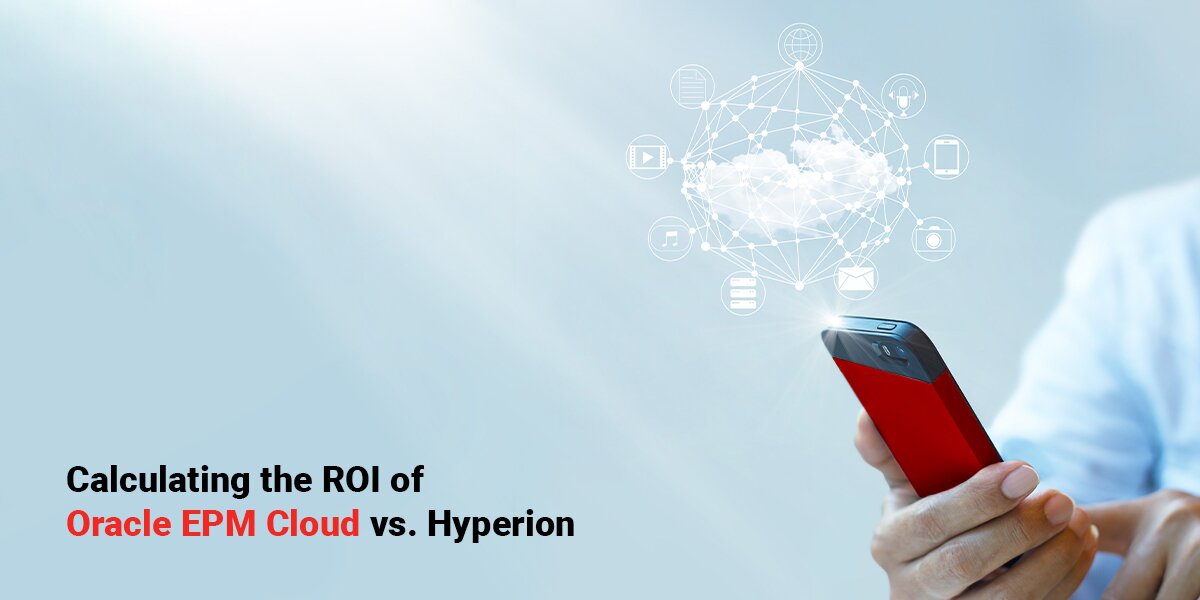Data is powering the next wave of digital transformation initiatives, driving analytics, forecasting, machine learning, and artificial intelligence forward. Within that context, organizations are looking at data as their go-to resource for smart decision-making and transformative results.
In today’s global market, organizations rely on Enterprise Performance Management (EPM) tools to perform accurate forecasting for budgets and financial processes to scale, up or down, productivity outputs and maximize results. Cue Oracle Hyperion EPM, which remains as the golden standard for Enterprise Performance Management in the industry thanks to its superior performance and platform for financial planning and budgeting, financial close management, and operational planning.
All of the above-mentioned tasks are mission-critical and require regular and ongoing maintenance and updates to keep systems running smoothly and safely. Oracle has included Oracle Hyperion EPM as part of its Applications Unlimited program and it’s now on version 11.2.8, ensuring that the on-premises version of the software will continue to receive periodic fixes, updates, and security patches, through at least 2032 under the Continuous Innovation model.
Oracle Hyperion EPM Modernization
Oracle Hyperion Planning
At the heart of Oracle’s EPM solution, Oracle Hyperion Planning supports planning, budgeting, and forecasting tasks. This powerful solution helps organizations generate intelligent computations and estimates backed by data, where the calculation engine offers robust functions and capabilities for statistical predictions and better forecasts. It’s also responsible for modeling so organizations can visually see potential outcomes.
Oracle Hyperion Planning works seamlessly with Microsoft Office tools such as Outlook, PowerPoint, and Excel, making it easy for organizations to consume data across multiple applications.
Thanks to dashboards, alerts, notifications, and more, Oracle Hyperion Planning is meant to be a highly collaborative workspace that also offers mobile interfaces for iOS, Android, and Windows devices.
Oracle Hyperion Financial Management
Part of the Oracle Hyperion Financial Management Close Suite, Oracle Hyperion Financial Management helps organizations consolidate and report on financial and operational performance.
In addition, this powerful resource helps track audits, ensure compliance with regulatory filings, and run robust analytics, all while working with Oracle Essbase Analytics, data warehouses, and other data sources.
Organizations rely on financial management solutions like Oracle Hyperion Financial Management to reduce cycle times, optimize spending, consolidate financial statements and data, file tax obligations, measure cash flow, and harness insights to boost performance and control risks with audit trails.
Oracle Essbase
Analytics tool that helps organizations perform real-time data analysis for massive amounts of financial data. Oracle Essbase is what’s known as an online analytical processing (OLAP) server, meaning that it powers forecasting, variance analysis, planning, modeling, root cause analysis, and much more, for custom and packaged applications.
Thanks to interfaces that users can select, Oracle Essbase presents query results for superior decision-making capabilities. It’s powerful enough to create queries out of the most complex data, yet friendly enough that users don’t need to be experts to extract reports. One of the key aspects of Oracle Essbase is that it categorizes data in dimensions, which can represent different things such as a business quarter or a product category. The speedy mathematical aggregations and calculations of Oracle Essbase are made possible by hierarchies of data so users can calculate, let’s say, product sales for a specific region.
In short, Oracle Essbase is a calculation engine that helps organizations plan, budget, forecast, and report, and can be hosted on-premises, at a data center, or as part of the SaaS Oracle EPM Cloud solution.
Future-Proofing your Oracle Hyperion EPM Investment
Oracle Hyperion EPM is now on release 11.2, version 11.2.8. Release 11.2 marked Oracle’s Hyperion EPM introduction into the Continuous Innovation model, meaning the product will be supported under the Premier Support umbrella through at least 2032.
When Oracle EPM 11.2 came into the picture, Oracle Hyperion EPM clients below said release were made aware of the costs and risks associated with losing Premier Support at the end of December 31, 2021, so it was imperative that either an upgrade to 11.2 or a cloud migration took place.
While many took action, many others did not, and with the deadline already expired, those clients are now in Sustaining Support or in Market Driven Support, with the latter being a pricier yet very limited option.
When looking at modernization options and future-proofing their Oracle Hyperion EPM investment, these are the criteria that clients need to assess:
1. Upgrading to 11.2
If staying on-premises is the right decision for the current needs of your business, we recommend that you upgrade to Hyperion release 11.2.x as soon as possible to leverage the innovations, security patches, and continued support that Oracle delivers. The upgrade is applicable to all the solution’s components.
Please note that you first need to upgrade to Oracle Hyperion EPM 11.1.2.4.XX before embarking on the upgrade to 11.2 if you’re not already there. You can use the Oracle RCU resource to populate databases and WebLogic data sources.
2. Migrating to the Cloud
Many clients took the release of 11.2 as the signal they were waiting for to migrate to the cloud. After all, organizations need to have a cloud strategy for the next 10 years to be able to cope and meet the modern business demands that will arise.
If you’re on the journey to the cloud, Oracle EPM Cloud is Oracle’s offering that frees you of hosting and maintenance headaches. Oracle EPM Cloud integrates with your ERP software and offers built-in analytics and intelligence.
As with any SaaS solution, you are no longer in full control of the application, so when Oracle upgrades the cloud solution, you will upgrade as well. Ultimately, this is a good thing because you’ll be getting the latest features, updates, fixes, and security patches with minimum downtime and no resource-strain on your side.
3. Technical and Budget Aspects
As stated earlier, if you decide to upgrade to 11.2, you must first be on 11.1.2.4.XX. There are a number of technical aspects that play a key role and could potentially make the upgrade process more complex. Same goes for the cloud.
For example, Oracle completely bypassed Windows Server 2016 and went straight to Windows Server 2019, which is the only operating system Oracle supports with 11.2, at least for the time being.
Clients can purchase Market Driven Support to receive limited support through at least 2032, but it’s costly and insufficient.
It’s recommended that you wisely spend your Oracle Hyperion EPM budget in upgrading instead of partially covering your investment for a few months. By being upgraded to 11.2, not only will you be saving money, you will also reap the benefits of being on Oracle’s most up-to-date version, keeping your financial processes productive and protected.
Oracle EPM Cloud Vs. Hyperion
With more than 20 years in the market, Oracle Hyperion has become the golden standard in the industry for EPM solutions. While many feared that the on-premises version of Hyperion was a dying cause, Oracle strengthened its commitment by making it a part of the Continuous Innovation model that promises Premier Support through at least 2032 as mentioned earlier, with ongoing delivery of updates, fixes, and security patches.
Still, organizations need to have a cloud strategy in the next 10 years as the migration to the cloud is imminent for those looking to accelerate their digital transformation journeys and ensure being able to work with the most modern, up-to-date software applications out there. Based on your unique situation and specific business needs, you need to carefully evaluate what the right, short-term and long-term steps are for your business.
Understanding the total cost of Hyperion EPM and its ROI, it’s important that you perform a deep-dive assessment of what both the on-premises and cloud-based solution models perform like in terms of direct and indirect costs and benefits.

As a benchmark, research commissioned by Oracle has shown in the past that every dollar invested in EPM can potentially yield a 200% increase in accrued profit after five years.
Now, measuring the profitability of your Hyperion investment can help indicate what modernization steps to take or which technology to move to. Overall, it’s a great data point to make strategic decisions about your Hyperion software, including a robust evaluation between the on-premises and cloud options.
Oracle EPM Cloud is an express ticket for companies looking to achieve scalability, agility, high-performance, and lower the total cost of ownership in stark contrast to its on-premises counterpart. Here are some of the main ROI components when evaluating both solutions.
Costs & Pricing
Application owners are always looking for ways to save money. Inherently, cloud solutions are well-known for their subscription-type model where users only pay a fee rather than purchasing an on-premises solution with a large investment made upfront. If you’ve been working with Hyperion for many years now, chances are that your Hyperion software is already generating benefits and overcoming the time value of money.
To reiterate, keep in mind that SaaS solutions like Oracle EPM Cloud enable you to pay a monthly or annual fee for the use of the software solution. Hyperion on-premises requires you to make a significant upfront investment.
Also worth mentioning is the cost of hardware. Of course, Oracle EPM Cloud is free of these types of expenditures while Hyperion on-premises calls for hardware, install fees, maintenance costs, and more.
Easy deployment
ROI is impacted by how flexible and quick it is to deploy a software solution. Cloud-based solutions are the clear winner in this debate as it seamlessly gives users more control, storage, and sometimes more features than on-premises solutions. Of course, on-premises solutions give you more control and flexibility when it comes to choosing the right third-party integrations (this of course can cost you more as you have to set up sufficient infrastructure to support those integrations).
Stability and Security
Oracle EPM Cloud, being a cloud platform, is a stranger to downtime and if the situation takes place, it is quick to fix the issue. Also, Oracle EPM Cloud is easier to manage through mobile devices, something that’s simply not the case in Hyperion on-premises where users need to be physically present at the place where the solution is installed.
In terms of security, both Oracle EPM Cloud and Hyperion on-premises offer robust security capabilities that protect your investment. In the cloud, it’s easy to strengthen security remotely with the added bonus of having your backups prepared for you instead of you having to be responsible for them. While on-premises, it’s easier for you to control all aspects of your system’ security, typically having an in-house team that can quickly engage in disaster recovery while completely owning the storage and backup management process.
Should you Upgrade or Migrate?
The age old question and it’s a tricky one. The reality is that you need a full assessment of your environment before deciding what option suits your unique business needs the best. There are many key elements that need to be looked at when deciding between upgrading to EPM 11.2 or migrating to EPM Cloud, so it’s best practice that you work with a managed service provider to help you identify these areas and focus on the outcomes you’re looking for.
You can map out your upgrade journey to 11.2 as you work towards moving to the cloud, directly upgrade to 11.2, or directly migrate to the cloud. All options are up for exploration, but it really takes rich expertise to see those panoramic views of your business.



